University Research Proposal: Political Conflicts in Social Media
VerifiedAdded on 2023/05/28
|29
|6541
|444
Project
AI Summary
This document presents a research proposal that investigates the influence of social media on political conflicts and contentious politics. The proposal begins with an overview of the problem, highlighting how social media has reshaped communication and become a battleground for political discourse. It outlines the research aim, objectives, and questions, which focus on understanding the expansion and significance of social media, analyzing political conflicts, identifying the mechanisms that facilitate these conflicts, and providing recommendations for mitigation. The literature review explores the growth and significance of social media, its various types, and its role in political conflicts. It also examines the mechanisms that facilitate conflict and contentious politics over social media. The proposed research methodology includes the research philosophy, approach, design, strategy, data collection and analysis processes, along with ethical considerations. The research aims to analyze the political conflicts in the social media and provide recommendations for mitigating conflict and contentious politics over the social media. It is significant as conducting this research will help in analyzing the various political conflicts over the social media. This study aims towards understanding and analyzing the concept and significance of social media and its role in supporting and criticizing the various political scenarios.
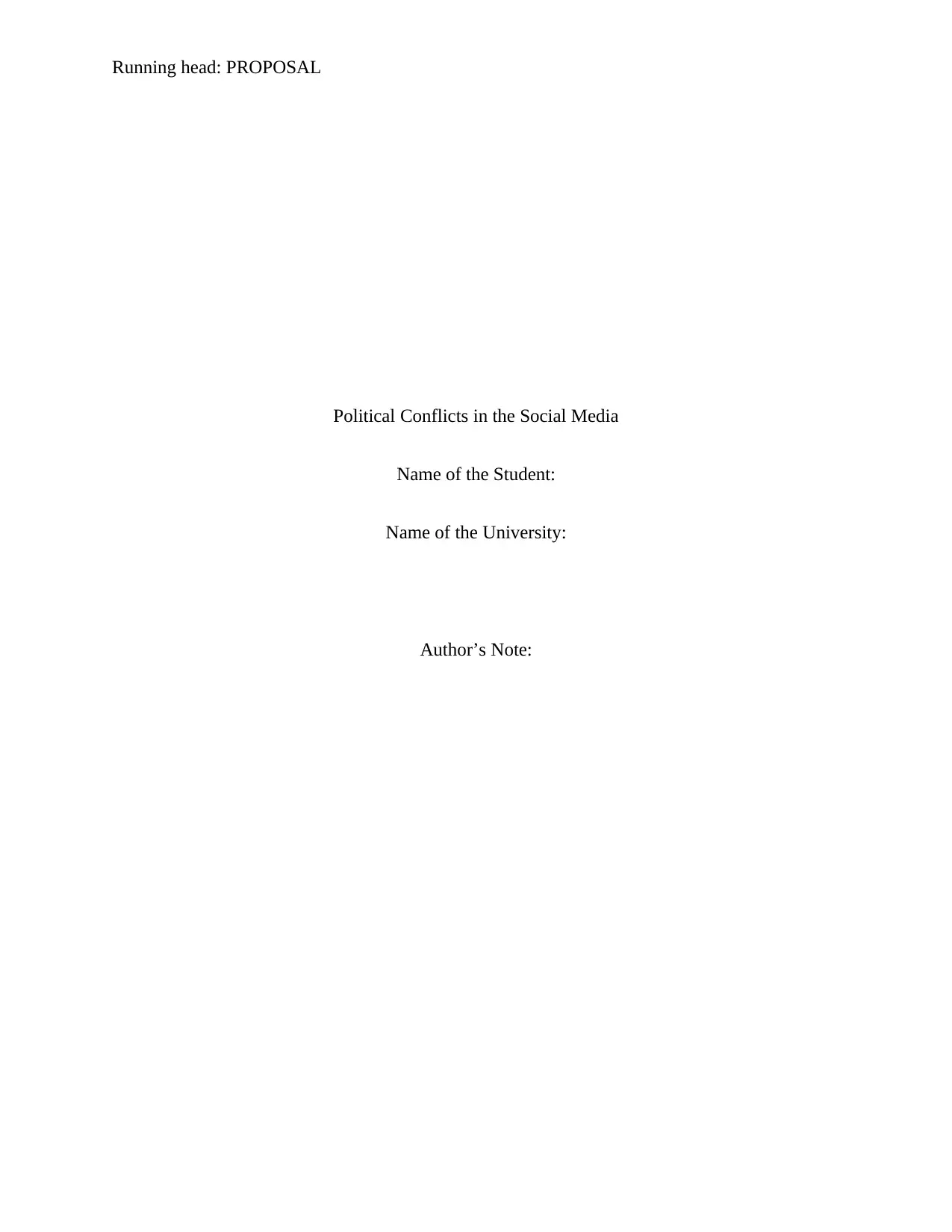
Running head: PROPOSAL
Political Conflicts in the Social Media
Name of the Student:
Name of the University:
Author’s Note:
Political Conflicts in the Social Media
Name of the Student:
Name of the University:
Author’s Note:
Paraphrase This Document
Need a fresh take? Get an instant paraphrase of this document with our AI Paraphraser
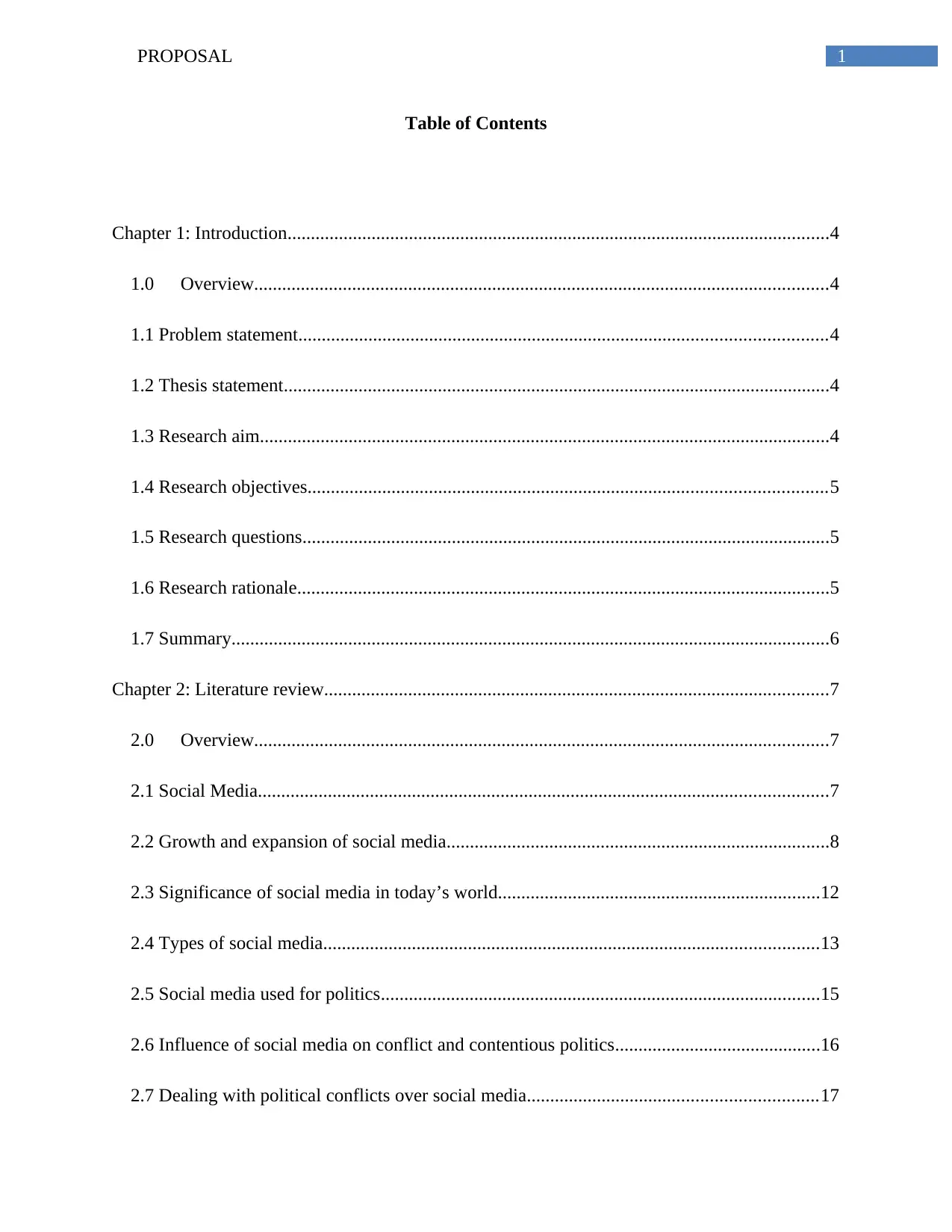
1PROPOSAL
Table of Contents
Chapter 1: Introduction....................................................................................................................4
1.0 Overview...........................................................................................................................4
1.1 Problem statement.................................................................................................................4
1.2 Thesis statement.....................................................................................................................4
1.3 Research aim..........................................................................................................................4
1.4 Research objectives...............................................................................................................5
1.5 Research questions.................................................................................................................5
1.6 Research rationale..................................................................................................................5
1.7 Summary................................................................................................................................6
Chapter 2: Literature review............................................................................................................7
2.0 Overview...........................................................................................................................7
2.1 Social Media..........................................................................................................................7
2.2 Growth and expansion of social media..................................................................................8
2.3 Significance of social media in today’s world.....................................................................12
2.4 Types of social media..........................................................................................................13
2.5 Social media used for politics..............................................................................................15
2.6 Influence of social media on conflict and contentious politics............................................16
2.7 Dealing with political conflicts over social media..............................................................17
Table of Contents
Chapter 1: Introduction....................................................................................................................4
1.0 Overview...........................................................................................................................4
1.1 Problem statement.................................................................................................................4
1.2 Thesis statement.....................................................................................................................4
1.3 Research aim..........................................................................................................................4
1.4 Research objectives...............................................................................................................5
1.5 Research questions.................................................................................................................5
1.6 Research rationale..................................................................................................................5
1.7 Summary................................................................................................................................6
Chapter 2: Literature review............................................................................................................7
2.0 Overview...........................................................................................................................7
2.1 Social Media..........................................................................................................................7
2.2 Growth and expansion of social media..................................................................................8
2.3 Significance of social media in today’s world.....................................................................12
2.4 Types of social media..........................................................................................................13
2.5 Social media used for politics..............................................................................................15
2.6 Influence of social media on conflict and contentious politics............................................16
2.7 Dealing with political conflicts over social media..............................................................17
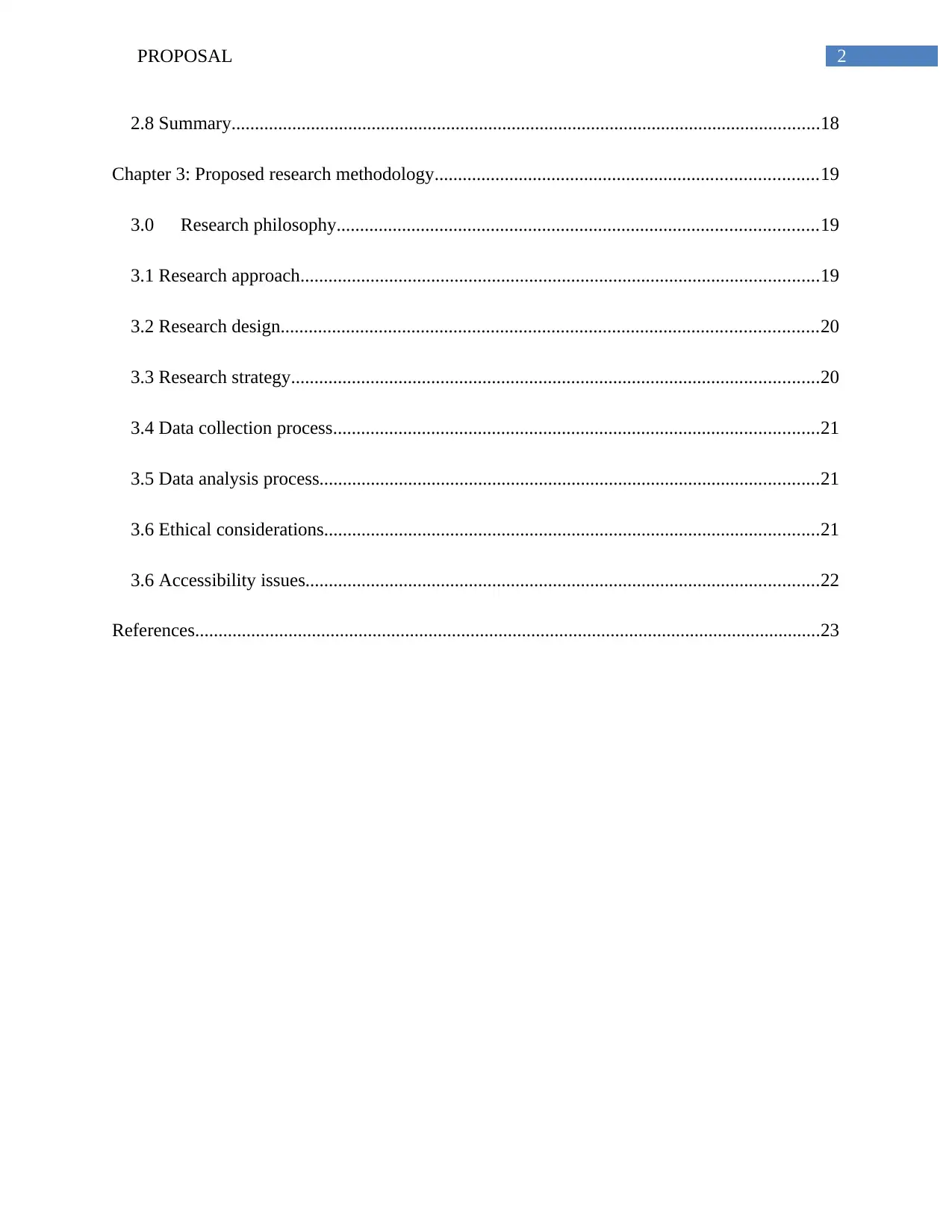
2PROPOSAL
2.8 Summary..............................................................................................................................18
Chapter 3: Proposed research methodology..................................................................................19
3.0 Research philosophy.......................................................................................................19
3.1 Research approach...............................................................................................................19
3.2 Research design...................................................................................................................20
3.3 Research strategy.................................................................................................................20
3.4 Data collection process........................................................................................................21
3.5 Data analysis process...........................................................................................................21
3.6 Ethical considerations..........................................................................................................21
3.6 Accessibility issues..............................................................................................................22
References......................................................................................................................................23
2.8 Summary..............................................................................................................................18
Chapter 3: Proposed research methodology..................................................................................19
3.0 Research philosophy.......................................................................................................19
3.1 Research approach...............................................................................................................19
3.2 Research design...................................................................................................................20
3.3 Research strategy.................................................................................................................20
3.4 Data collection process........................................................................................................21
3.5 Data analysis process...........................................................................................................21
3.6 Ethical considerations..........................................................................................................21
3.6 Accessibility issues..............................................................................................................22
References......................................................................................................................................23
⊘ This is a preview!⊘
Do you want full access?
Subscribe today to unlock all pages.

Trusted by 1+ million students worldwide
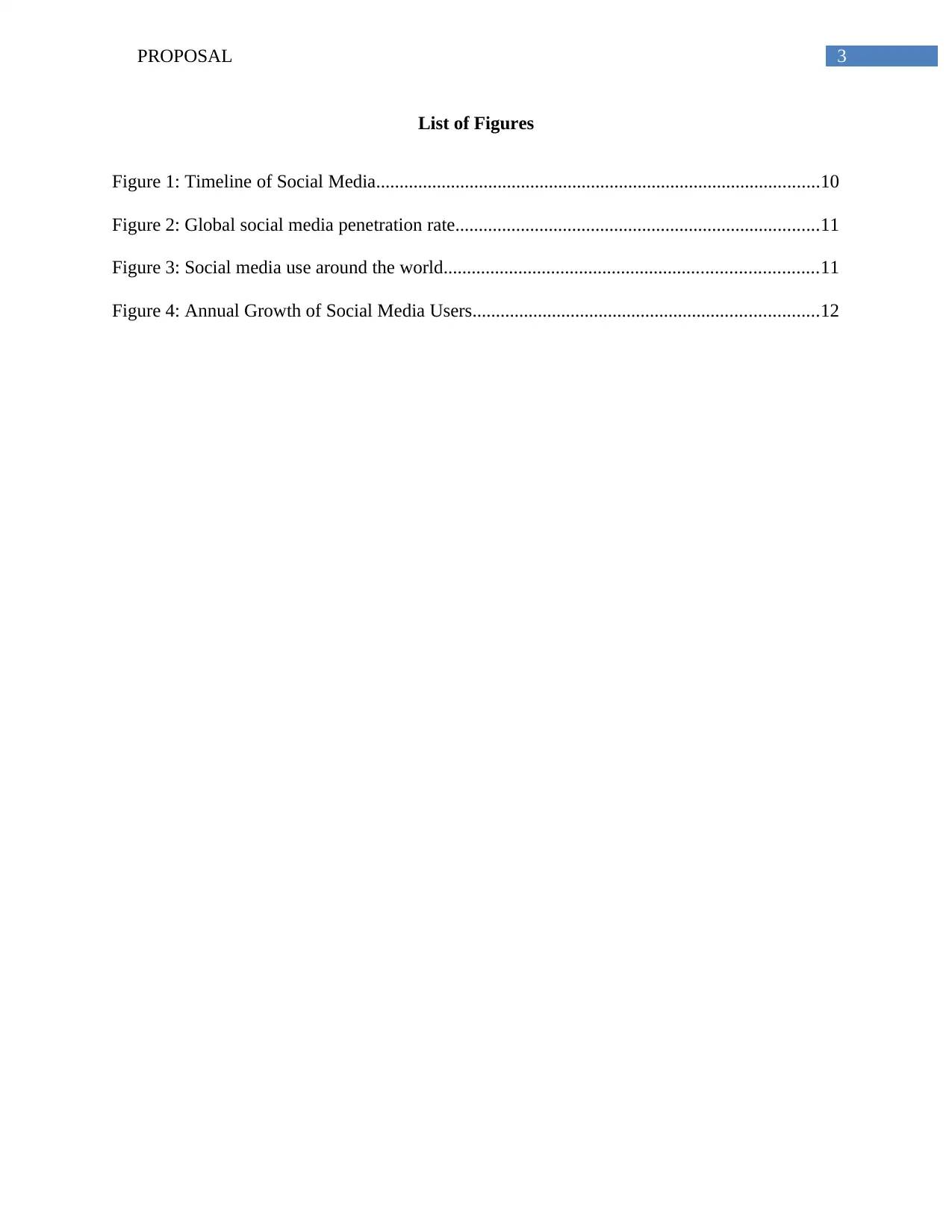
3PROPOSAL
List of Figures
Figure 1: Timeline of Social Media...............................................................................................10
Figure 2: Global social media penetration rate..............................................................................11
Figure 3: Social media use around the world................................................................................11
Figure 4: Annual Growth of Social Media Users..........................................................................12
List of Figures
Figure 1: Timeline of Social Media...............................................................................................10
Figure 2: Global social media penetration rate..............................................................................11
Figure 3: Social media use around the world................................................................................11
Figure 4: Annual Growth of Social Media Users..........................................................................12
Paraphrase This Document
Need a fresh take? Get an instant paraphrase of this document with our AI Paraphraser
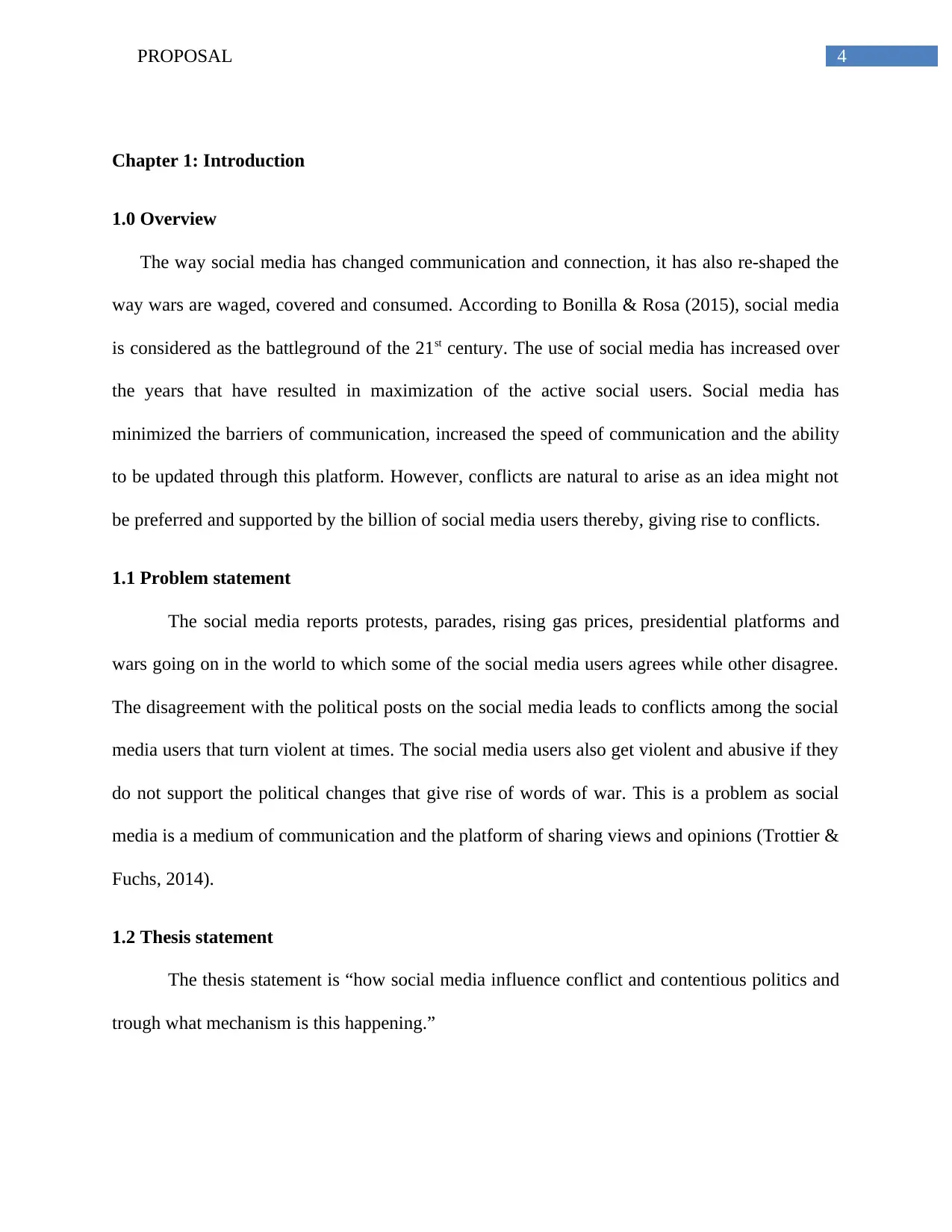
4PROPOSAL
Chapter 1: Introduction
1.0 Overview
The way social media has changed communication and connection, it has also re-shaped the
way wars are waged, covered and consumed. According to Bonilla & Rosa (2015), social media
is considered as the battleground of the 21st century. The use of social media has increased over
the years that have resulted in maximization of the active social users. Social media has
minimized the barriers of communication, increased the speed of communication and the ability
to be updated through this platform. However, conflicts are natural to arise as an idea might not
be preferred and supported by the billion of social media users thereby, giving rise to conflicts.
1.1 Problem statement
The social media reports protests, parades, rising gas prices, presidential platforms and
wars going on in the world to which some of the social media users agrees while other disagree.
The disagreement with the political posts on the social media leads to conflicts among the social
media users that turn violent at times. The social media users also get violent and abusive if they
do not support the political changes that give rise of words of war. This is a problem as social
media is a medium of communication and the platform of sharing views and opinions (Trottier &
Fuchs, 2014).
1.2 Thesis statement
The thesis statement is “how social media influence conflict and contentious politics and
trough what mechanism is this happening.”
Chapter 1: Introduction
1.0 Overview
The way social media has changed communication and connection, it has also re-shaped the
way wars are waged, covered and consumed. According to Bonilla & Rosa (2015), social media
is considered as the battleground of the 21st century. The use of social media has increased over
the years that have resulted in maximization of the active social users. Social media has
minimized the barriers of communication, increased the speed of communication and the ability
to be updated through this platform. However, conflicts are natural to arise as an idea might not
be preferred and supported by the billion of social media users thereby, giving rise to conflicts.
1.1 Problem statement
The social media reports protests, parades, rising gas prices, presidential platforms and
wars going on in the world to which some of the social media users agrees while other disagree.
The disagreement with the political posts on the social media leads to conflicts among the social
media users that turn violent at times. The social media users also get violent and abusive if they
do not support the political changes that give rise of words of war. This is a problem as social
media is a medium of communication and the platform of sharing views and opinions (Trottier &
Fuchs, 2014).
1.2 Thesis statement
The thesis statement is “how social media influence conflict and contentious politics and
trough what mechanism is this happening.”
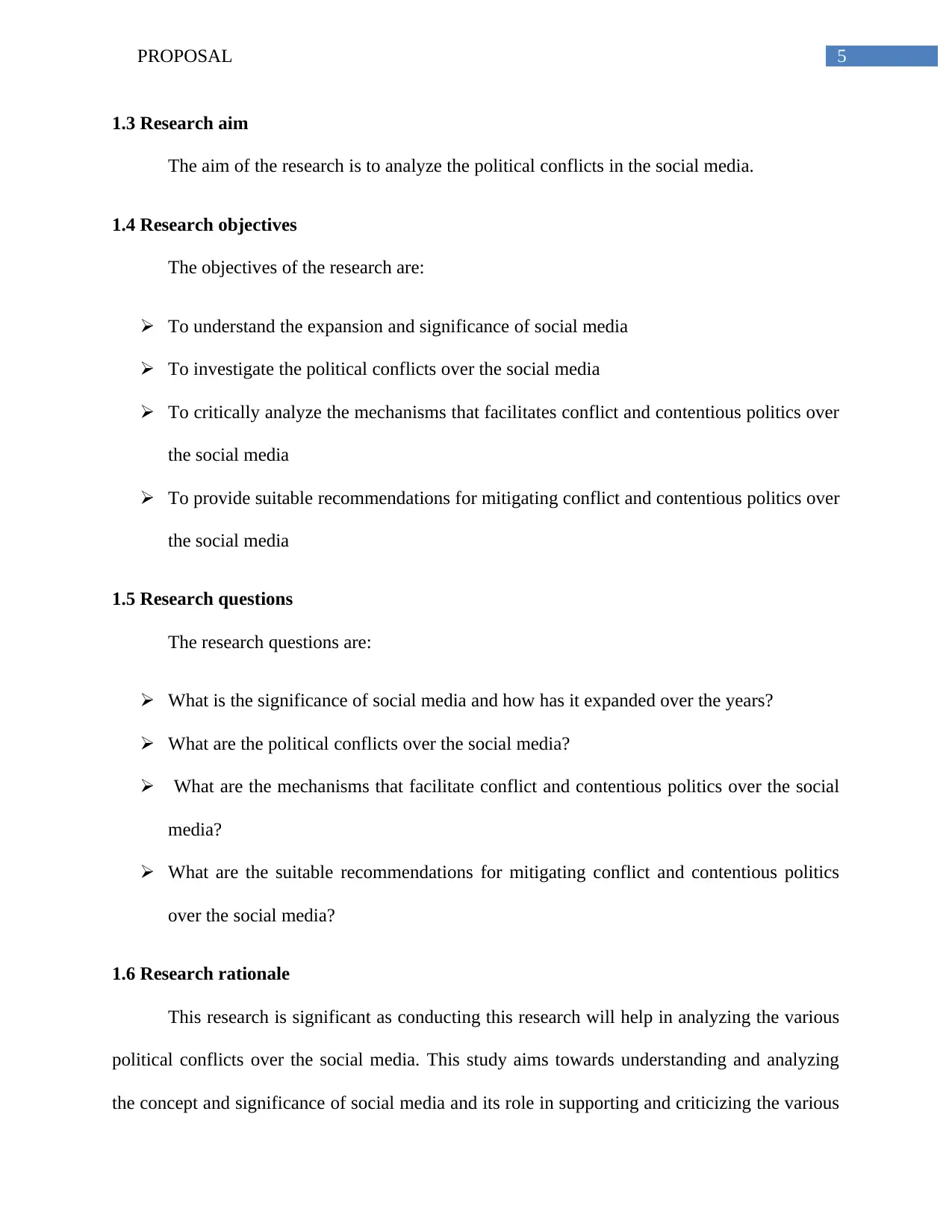
5PROPOSAL
1.3 Research aim
The aim of the research is to analyze the political conflicts in the social media.
1.4 Research objectives
The objectives of the research are:
To understand the expansion and significance of social media
To investigate the political conflicts over the social media
To critically analyze the mechanisms that facilitates conflict and contentious politics over
the social media
To provide suitable recommendations for mitigating conflict and contentious politics over
the social media
1.5 Research questions
The research questions are:
What is the significance of social media and how has it expanded over the years?
What are the political conflicts over the social media?
What are the mechanisms that facilitate conflict and contentious politics over the social
media?
What are the suitable recommendations for mitigating conflict and contentious politics
over the social media?
1.6 Research rationale
This research is significant as conducting this research will help in analyzing the various
political conflicts over the social media. This study aims towards understanding and analyzing
the concept and significance of social media and its role in supporting and criticizing the various
1.3 Research aim
The aim of the research is to analyze the political conflicts in the social media.
1.4 Research objectives
The objectives of the research are:
To understand the expansion and significance of social media
To investigate the political conflicts over the social media
To critically analyze the mechanisms that facilitates conflict and contentious politics over
the social media
To provide suitable recommendations for mitigating conflict and contentious politics over
the social media
1.5 Research questions
The research questions are:
What is the significance of social media and how has it expanded over the years?
What are the political conflicts over the social media?
What are the mechanisms that facilitate conflict and contentious politics over the social
media?
What are the suitable recommendations for mitigating conflict and contentious politics
over the social media?
1.6 Research rationale
This research is significant as conducting this research will help in analyzing the various
political conflicts over the social media. This study aims towards understanding and analyzing
the concept and significance of social media and its role in supporting and criticizing the various
⊘ This is a preview!⊘
Do you want full access?
Subscribe today to unlock all pages.

Trusted by 1+ million students worldwide
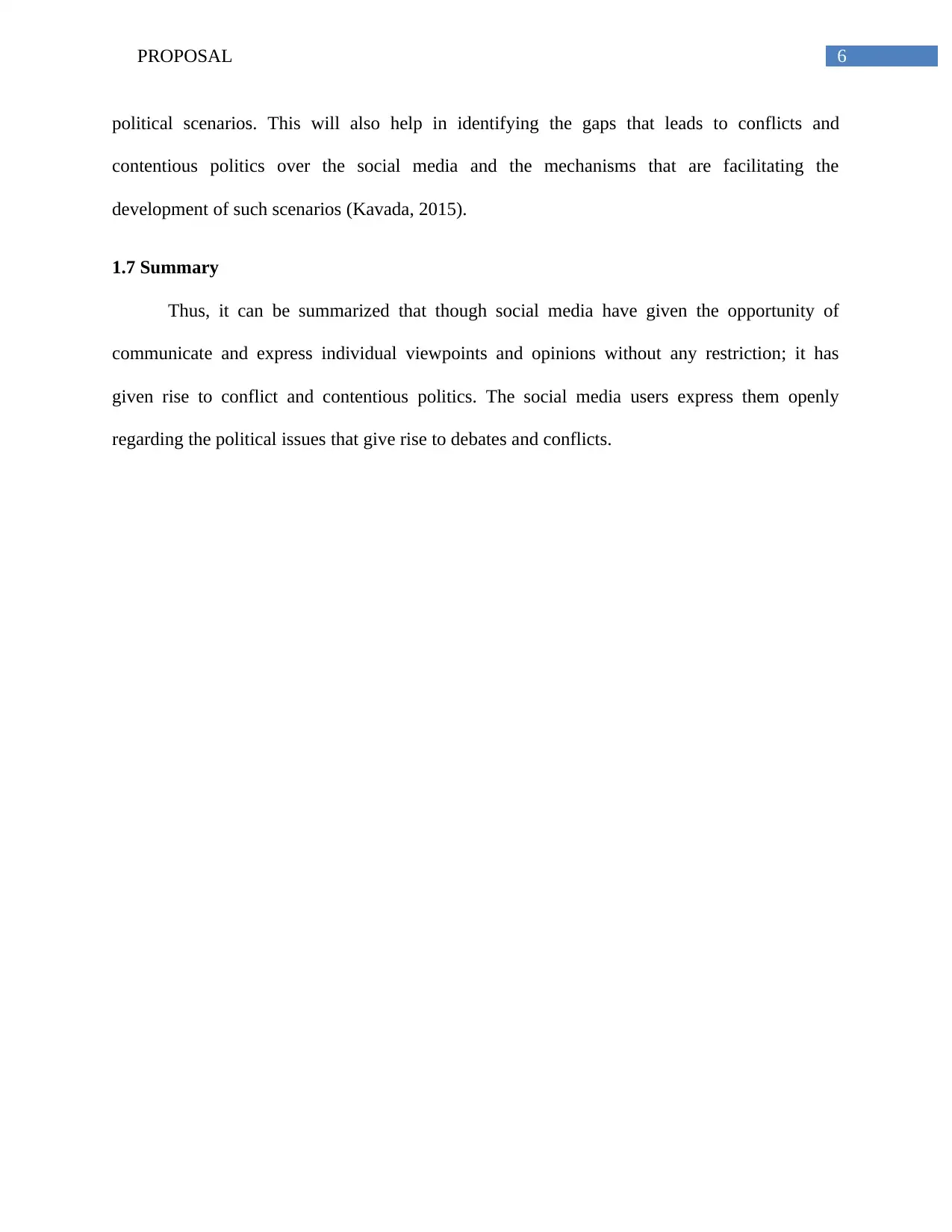
6PROPOSAL
political scenarios. This will also help in identifying the gaps that leads to conflicts and
contentious politics over the social media and the mechanisms that are facilitating the
development of such scenarios (Kavada, 2015).
1.7 Summary
Thus, it can be summarized that though social media have given the opportunity of
communicate and express individual viewpoints and opinions without any restriction; it has
given rise to conflict and contentious politics. The social media users express them openly
regarding the political issues that give rise to debates and conflicts.
political scenarios. This will also help in identifying the gaps that leads to conflicts and
contentious politics over the social media and the mechanisms that are facilitating the
development of such scenarios (Kavada, 2015).
1.7 Summary
Thus, it can be summarized that though social media have given the opportunity of
communicate and express individual viewpoints and opinions without any restriction; it has
given rise to conflict and contentious politics. The social media users express them openly
regarding the political issues that give rise to debates and conflicts.
Paraphrase This Document
Need a fresh take? Get an instant paraphrase of this document with our AI Paraphraser
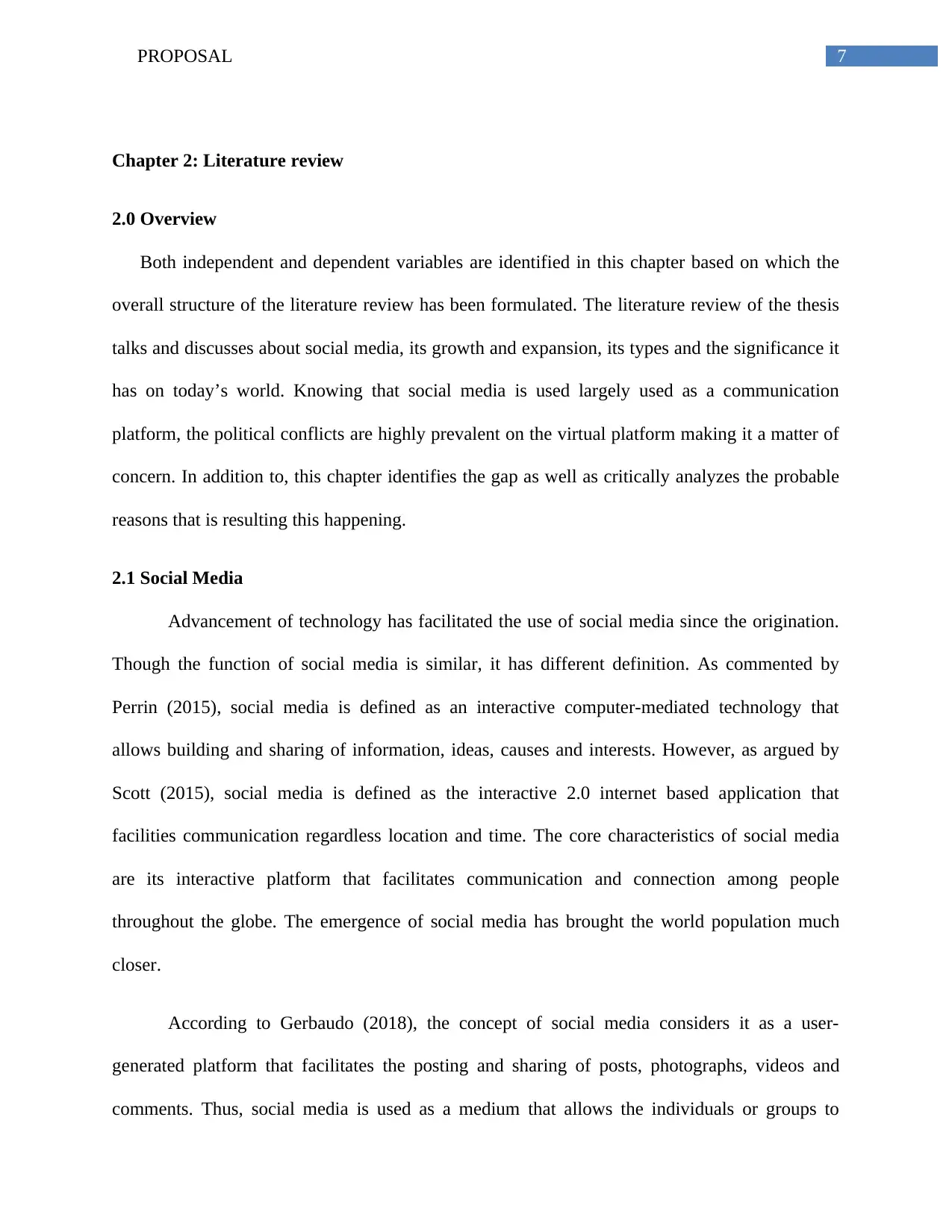
7PROPOSAL
Chapter 2: Literature review
2.0 Overview
Both independent and dependent variables are identified in this chapter based on which the
overall structure of the literature review has been formulated. The literature review of the thesis
talks and discusses about social media, its growth and expansion, its types and the significance it
has on today’s world. Knowing that social media is used largely used as a communication
platform, the political conflicts are highly prevalent on the virtual platform making it a matter of
concern. In addition to, this chapter identifies the gap as well as critically analyzes the probable
reasons that is resulting this happening.
2.1 Social Media
Advancement of technology has facilitated the use of social media since the origination.
Though the function of social media is similar, it has different definition. As commented by
Perrin (2015), social media is defined as an interactive computer-mediated technology that
allows building and sharing of information, ideas, causes and interests. However, as argued by
Scott (2015), social media is defined as the interactive 2.0 internet based application that
facilities communication regardless location and time. The core characteristics of social media
are its interactive platform that facilitates communication and connection among people
throughout the globe. The emergence of social media has brought the world population much
closer.
According to Gerbaudo (2018), the concept of social media considers it as a user-
generated platform that facilitates the posting and sharing of posts, photographs, videos and
comments. Thus, social media is used as a medium that allows the individuals or groups to
Chapter 2: Literature review
2.0 Overview
Both independent and dependent variables are identified in this chapter based on which the
overall structure of the literature review has been formulated. The literature review of the thesis
talks and discusses about social media, its growth and expansion, its types and the significance it
has on today’s world. Knowing that social media is used largely used as a communication
platform, the political conflicts are highly prevalent on the virtual platform making it a matter of
concern. In addition to, this chapter identifies the gap as well as critically analyzes the probable
reasons that is resulting this happening.
2.1 Social Media
Advancement of technology has facilitated the use of social media since the origination.
Though the function of social media is similar, it has different definition. As commented by
Perrin (2015), social media is defined as an interactive computer-mediated technology that
allows building and sharing of information, ideas, causes and interests. However, as argued by
Scott (2015), social media is defined as the interactive 2.0 internet based application that
facilities communication regardless location and time. The core characteristics of social media
are its interactive platform that facilitates communication and connection among people
throughout the globe. The emergence of social media has brought the world population much
closer.
According to Gerbaudo (2018), the concept of social media considers it as a user-
generated platform that facilitates the posting and sharing of posts, photographs, videos and
comments. Thus, social media is used as a medium that allows the individuals or groups to
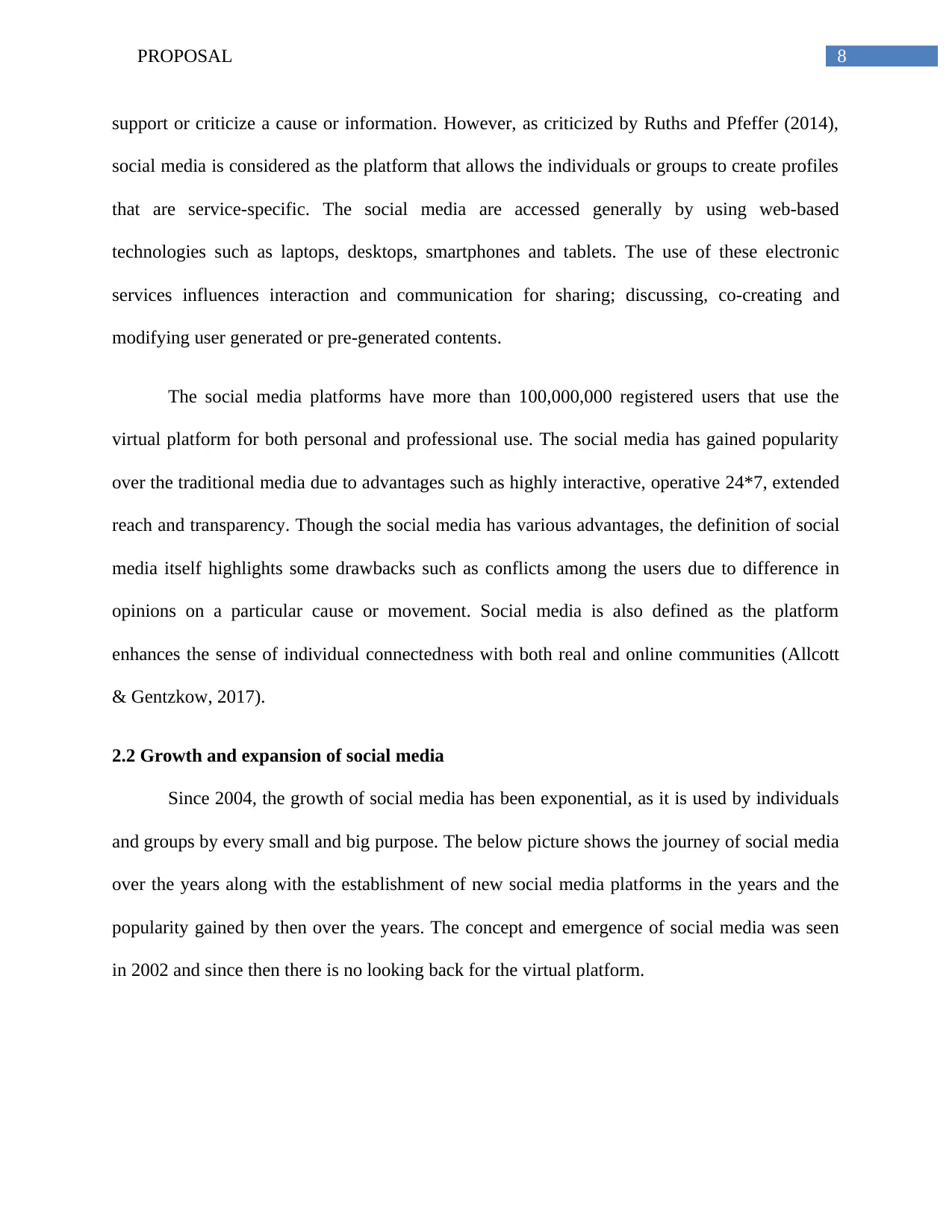
8PROPOSAL
support or criticize a cause or information. However, as criticized by Ruths and Pfeffer (2014),
social media is considered as the platform that allows the individuals or groups to create profiles
that are service-specific. The social media are accessed generally by using web-based
technologies such as laptops, desktops, smartphones and tablets. The use of these electronic
services influences interaction and communication for sharing; discussing, co-creating and
modifying user generated or pre-generated contents.
The social media platforms have more than 100,000,000 registered users that use the
virtual platform for both personal and professional use. The social media has gained popularity
over the traditional media due to advantages such as highly interactive, operative 24*7, extended
reach and transparency. Though the social media has various advantages, the definition of social
media itself highlights some drawbacks such as conflicts among the users due to difference in
opinions on a particular cause or movement. Social media is also defined as the platform
enhances the sense of individual connectedness with both real and online communities (Allcott
& Gentzkow, 2017).
2.2 Growth and expansion of social media
Since 2004, the growth of social media has been exponential, as it is used by individuals
and groups by every small and big purpose. The below picture shows the journey of social media
over the years along with the establishment of new social media platforms in the years and the
popularity gained by then over the years. The concept and emergence of social media was seen
in 2002 and since then there is no looking back for the virtual platform.
support or criticize a cause or information. However, as criticized by Ruths and Pfeffer (2014),
social media is considered as the platform that allows the individuals or groups to create profiles
that are service-specific. The social media are accessed generally by using web-based
technologies such as laptops, desktops, smartphones and tablets. The use of these electronic
services influences interaction and communication for sharing; discussing, co-creating and
modifying user generated or pre-generated contents.
The social media platforms have more than 100,000,000 registered users that use the
virtual platform for both personal and professional use. The social media has gained popularity
over the traditional media due to advantages such as highly interactive, operative 24*7, extended
reach and transparency. Though the social media has various advantages, the definition of social
media itself highlights some drawbacks such as conflicts among the users due to difference in
opinions on a particular cause or movement. Social media is also defined as the platform
enhances the sense of individual connectedness with both real and online communities (Allcott
& Gentzkow, 2017).
2.2 Growth and expansion of social media
Since 2004, the growth of social media has been exponential, as it is used by individuals
and groups by every small and big purpose. The below picture shows the journey of social media
over the years along with the establishment of new social media platforms in the years and the
popularity gained by then over the years. The concept and emergence of social media was seen
in 2002 and since then there is no looking back for the virtual platform.
⊘ This is a preview!⊘
Do you want full access?
Subscribe today to unlock all pages.

Trusted by 1+ million students worldwide
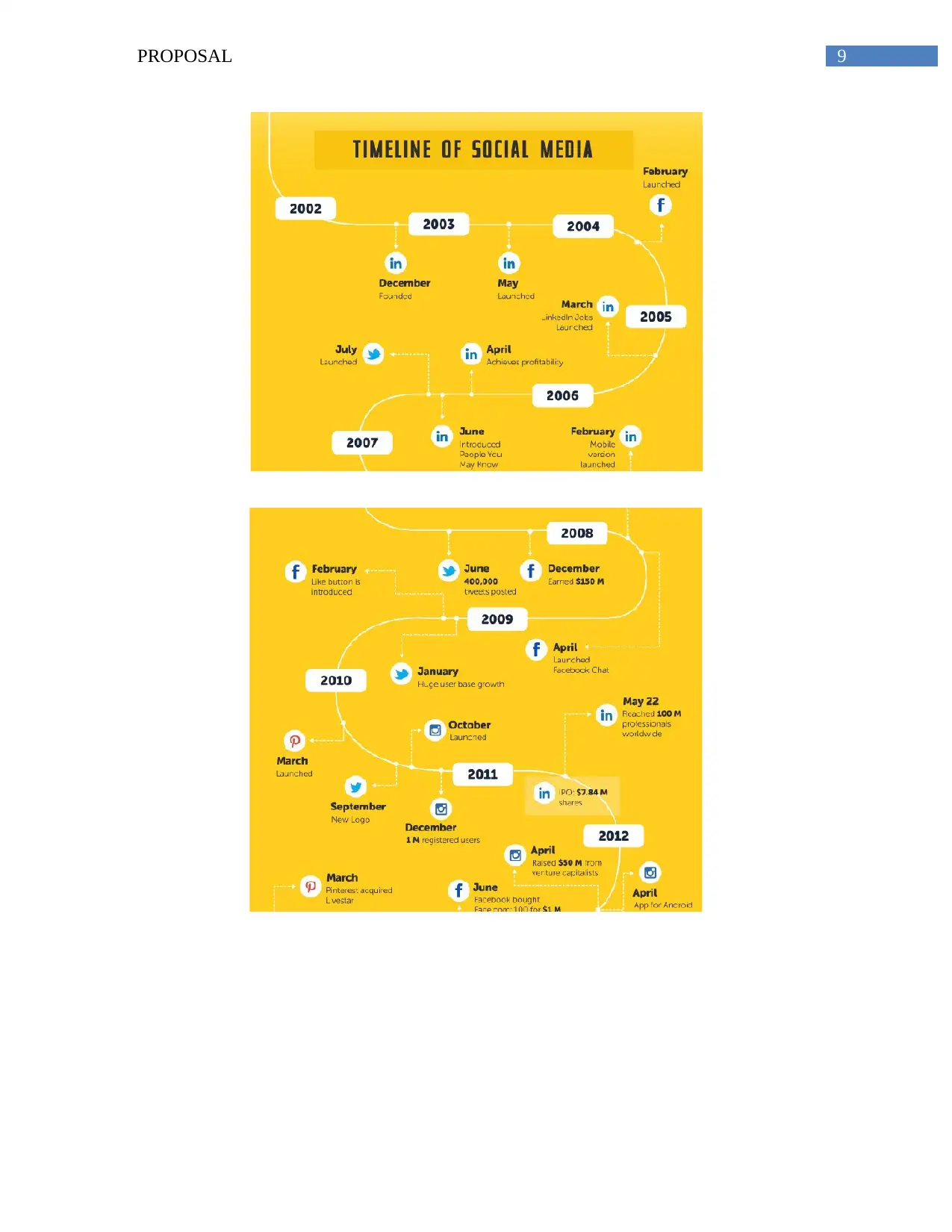
9PROPOSAL
Paraphrase This Document
Need a fresh take? Get an instant paraphrase of this document with our AI Paraphraser
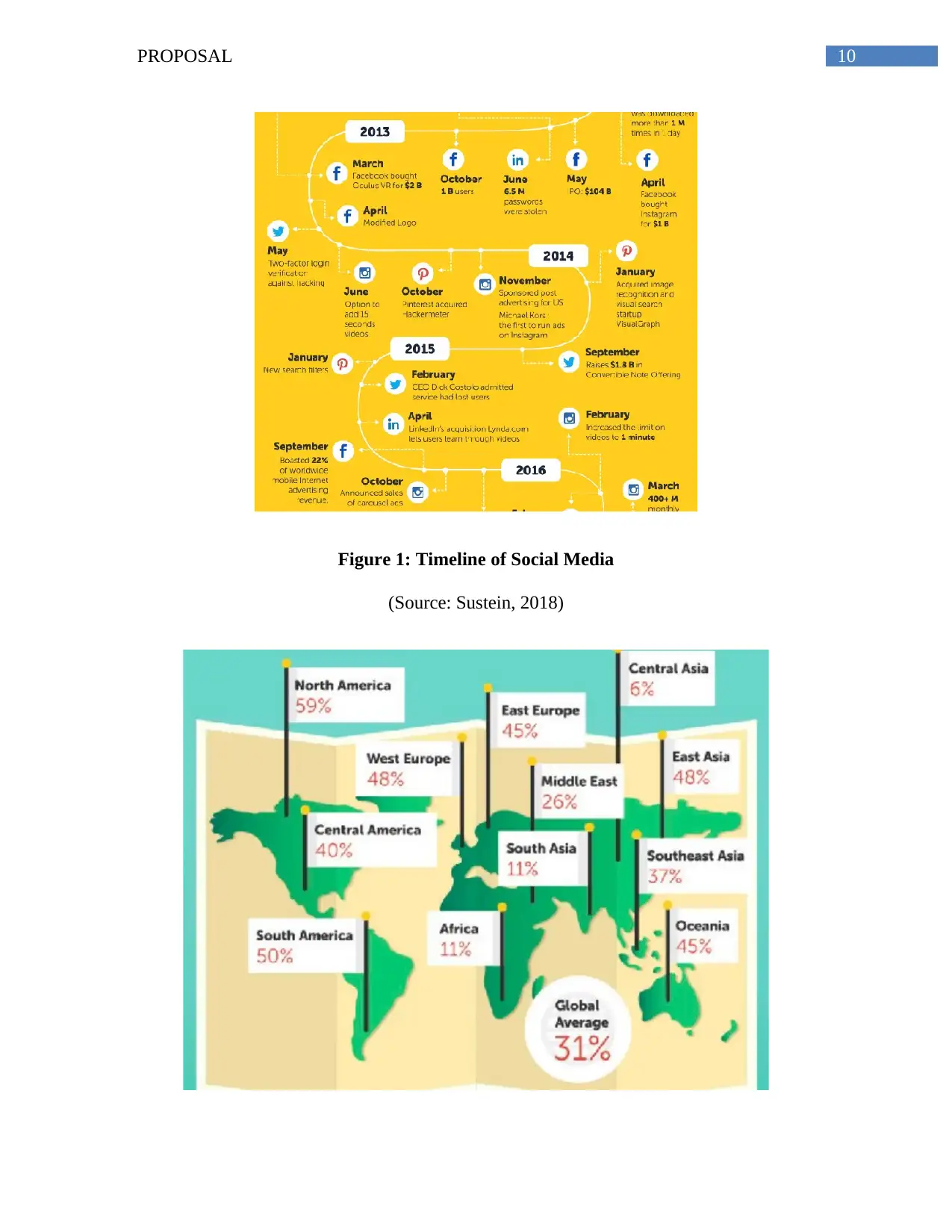
10PROPOSAL
Figure 1: Timeline of Social Media
(Source: Sustein, 2018)
Figure 1: Timeline of Social Media
(Source: Sustein, 2018)
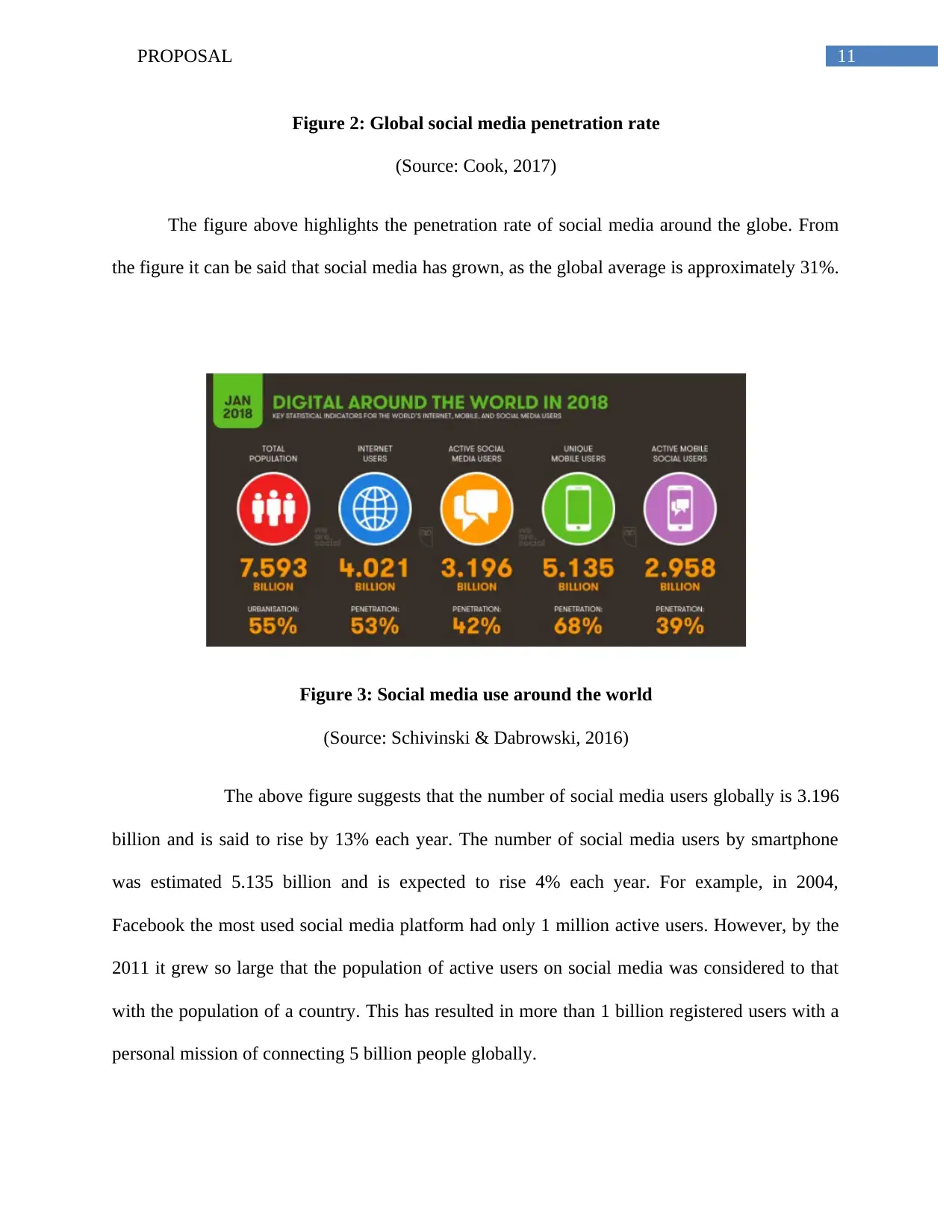
11PROPOSAL
Figure 2: Global social media penetration rate
(Source: Cook, 2017)
The figure above highlights the penetration rate of social media around the globe. From
the figure it can be said that social media has grown, as the global average is approximately 31%.
Figure 3: Social media use around the world
(Source: Schivinski & Dabrowski, 2016)
The above figure suggests that the number of social media users globally is 3.196
billion and is said to rise by 13% each year. The number of social media users by smartphone
was estimated 5.135 billion and is expected to rise 4% each year. For example, in 2004,
Facebook the most used social media platform had only 1 million active users. However, by the
2011 it grew so large that the population of active users on social media was considered to that
with the population of a country. This has resulted in more than 1 billion registered users with a
personal mission of connecting 5 billion people globally.
Figure 2: Global social media penetration rate
(Source: Cook, 2017)
The figure above highlights the penetration rate of social media around the globe. From
the figure it can be said that social media has grown, as the global average is approximately 31%.
Figure 3: Social media use around the world
(Source: Schivinski & Dabrowski, 2016)
The above figure suggests that the number of social media users globally is 3.196
billion and is said to rise by 13% each year. The number of social media users by smartphone
was estimated 5.135 billion and is expected to rise 4% each year. For example, in 2004,
Facebook the most used social media platform had only 1 million active users. However, by the
2011 it grew so large that the population of active users on social media was considered to that
with the population of a country. This has resulted in more than 1 billion registered users with a
personal mission of connecting 5 billion people globally.
⊘ This is a preview!⊘
Do you want full access?
Subscribe today to unlock all pages.

Trusted by 1+ million students worldwide
1 out of 29
Related Documents
Your All-in-One AI-Powered Toolkit for Academic Success.
+13062052269
info@desklib.com
Available 24*7 on WhatsApp / Email
![[object Object]](/_next/static/media/star-bottom.7253800d.svg)
Unlock your academic potential
Copyright © 2020–2025 A2Z Services. All Rights Reserved. Developed and managed by ZUCOL.




